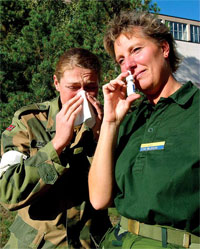 |
 |
 |
 Health & Beauty | February 2005 Health & Beauty | February 2005  
Grant Will Help Research Flu Bug
 BBCNews BBCNews

 Researchers at the University of Bath have won a grant to help produce a drug that could stop flu and several other diseases from replicating in humans. The £261,000 grant will provide new software and powerful computers to produce a designer drug blueprint. Researchers at the University of Bath have won a grant to help produce a drug that could stop flu and several other diseases from replicating in humans. The £261,000 grant will provide new software and powerful computers to produce a designer drug blueprint.

The drug would work by being chemically very similar to part of the protective coating around cells in the throat that the flu virus first attacks. The flu bug would be "tricked" into attacking the drug instead of cells.

The three-year project will be largely carried out by examining the behaviour of atoms of the influenza virus which attack cells, and atoms of the throat cells that are attacked.

'Computer Modelling'

By using advanced software to model the way these atoms interact, the atomic structure of a suitable drug could be worked out. Drug design benefits from computer modelling as drugs are usually produced by trial and error in a process which could last many years.

Professor Ian Williams and his colleague Dr Gus Ruggiero from the university will use part of the grant from the Biotechnology and Biological Sciences Research Council to buy the powerful computers and specialist software.

"Developing a blueprint for a new way of fighting influenza is a very important task," said Professor Williams.

"We often think of flu as just a nasty illness which puts us in bed for a few days. But some outbreaks can cause death on a large scale - the world-wide outbreak in 1918 killed more people than the First World War itself."

Because of similarities between the enzymes used by different viruses and bacteria, a similar approach may also be useful in fighting other diseases such as the South American sleeping sickness, Chagas Disease. | 
 | |
 |



